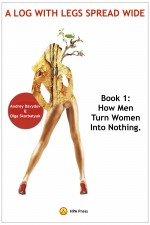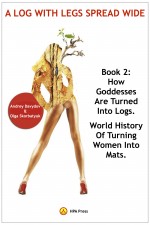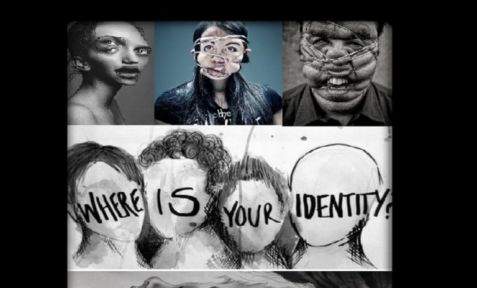ISBN: 9781311155771, 9781311915603
(Purchase an eBook or an AudioBook. | Also available in Russian here.)
A LOG WITH LEGS SPREAD WIDE
Andrey Davydov and Olga Skorbatyuk
Translated by Kate Bazilevsky
Book 1: How Men Turn Women Into Nothing

Regardless of race, ethnicity, profession and so on, every woman considers herself an individual. In vain, as no woman is an individual. Any woman lives as man programmed her to live, as it is convenient, as he wants her to.
A woman lives by that “software,” which she has been filled with since the moment of birth by images, pictures, and portrayals. These are pictures with smell, color, with sensations from touch. In other words, a film, but of better quality, one where a woman by herself can be present in her own self. This place is called imagination, fantasies and dreams. There, a woman thinks that she has freedom: my pictures, my dreams, my personal life, my secrets… Really? Where did she get these pictures? Where did her parents get these pictures?
If all pictures, films of an adult woman got erased, she would turn into a newborn child, a baby in an adult body. So, the presence of a system of images in a woman is the foundation of her life, from beginning to end. The truth is that the whole picture system is created based on artificial images taken from society. In society, women do not create artificial images. They can be considered artificial because they are created by men, on the basis of male fantasies, with their pictures of a woman.
Now, let’s consider this in more detail.
Every person has some inner space. Some call it imagination, fantasy, dreams, memories, thoughts, daydreams, visions; we added to the list by naming it a “virtual room.” All people do what they want in this space, from calculations to the most elementary actions (“What to eat for lunch?”), to modeling of complex engineering or architectural structures, to generating ideologies for entire nations, rendering functions of global systems and processes. Besides questions like “What lipstick should I choose?” or “Which tie to wear with this suit?” that “virtual room” is where people create new religions and philosophies, movie scripts, literature, operation plans of huge industrial or business structures.
By analogy, a “virtual room” is a cinema where a person watches movies. Only in addition to visuals and sounds, a movie in a virtual room includes smells, taste, and tactile sensations. The whole range of human perception is present in images of the virtual room. He or she may be there actively, creating movies no worse than any filmmaker, or passively, as a spectator of films that pass in front of the inner eye. The position of a spectator is usually perceived as visions, memories, or dreams. But, in all cases any person sees some images inside him or her self.
Often one’s “virtual room” is regarded as the place where a person thinks, ponders, plans and analyzes. The words “I need to think,” mean that the subject is now going to “falls deep within him or her self,” into the “virtual room.” However, these actions do not relate to the thinking process, and especially not for women (as to why, will be explained later). And, since somehow a woman got used to “thinking” in the space of her own imagination, she immediately begins to see nothing else, but images (despite the fact that some people mistakenly believe that people think with words).
On average, by fifteen years of age any woman becomes a subject who is perceived by her own self and others as an individual with her own character, philosophy, habits, life experiences, and preferences. It is considered that this personality is unique, original and unrepeatable, that no two women are absolutely similar to each other, like clones. Indeed, this is the case.
Every woman inherits her unique baggage of information about the world, about other people, and her self in particular from parents and/or mentors. Along with this baggage, she gets guidelines on what she needs to be like and how she should live. But, during adolescence any girl rebels against this. Because, like shoes that are too small, this inheritance presses, squeezes, brings immense discomfort and therefore causes a terrible rage. In this sense, love for parents does not play any role because you can greatly respect someone who gave you a pair of shoes that are not your size, but you will not be able to wear them.
Therefore, as a teenager any girl makes an audit of that what she got as vital recipes from parents and/or mentors, and makes adaptations. Adaptations are needed, first of all, in order to accommodate the recipes to her self, to make them possible and convenient for use; secondly—to conform to modernity since parents (mentors) created these life recipes during an entirely different era.
In most cases, a woman forgets or ignores the fact that her personality was constructed from material that was handed over by parents and/or mentors. This happens because the new personality that a woman made of her self (as she believes) differs from the previous one, and often, as she believes, quite significantly. Although from our point of view, it does not, as work on the reformation, accommodations of already established gets confused with creation.
As a result, a so-called “Self-Image” gets created in a woman’s virtual room, and, not just an image, but in fact she herself, from A to Z. It is impossible for her not to engage in this process because a human being, just like a computer, does not work without a program. No wonder a woman perceives this so-called “Self-Image” as the foundation of her life after its creation because in reality she begins to live and function strictly according to this image. In other words, she really becomes that what, among other things, she imagined to her self about her self. Sometimes even her physical appearance changes. She really becomes somewhat different, at least because she stops being a child who lives strictly by her parents’ “Image and Likeness.” A woman perceives this as “birth of an Individual;” moreover, an individual who supposedly will grow and evolve.
In practice, however, a so-called “Self-Image” created from fifteen to twenty years of age does not evolve, does not advance. Advancement and progression are changes, and women usually leave their “bright image” unchanged until death. Minor adjustments do not count. The essence, the foundation as personal philosophy, recipes what to be like and how to live as a lifestyle are a base that is extremely carefully guarded by the proprietress. And, it is not subject to any cardinal changes. Instead, a woman is ready to change the whole world and other people to be according to her “Self-Image.” To her, it is the cornerstone on which she stands, her roots, her greatest treasure. She is rather willing to die than, as they say, “cheat on her self…”
But, the question is: would that really be cheating on HER SELF?
What is the essence of this notorious “Self-Image?” It is nothing else, but a type of a “film library,” an archive with an enormous number of videos. And, behind each one of these “movies” are images. Every woman has a huge number of such “videotapes,” as it is a requirement to have an image for each function carried out by a human, this is just how nature arranged it. However, first of all, a woman does not perceive this “film library” as such. Secondly, women do not have a slightest idea about images themselves, do not know anything about the effect that any image has on human psychophysiology. But that is not the worst.
The most terrible thing is that women do not even suspect who and why produces images for their imagination.
Women call their, figuratively speaking, “home theater” by different names: “My soul, My inner world, My individuality, My self, My inner core,” and so on. But, more importantly, they associate this “cinema” with their selves. They tell themselves: “This is me—the real me.” And, indeed, they fully merge with the images that they themselves, as they think, have come up with in order to be, to live, to function. Any woman fights for this “soul” with incredible fury. (Although this has nothing to do with soul because a “virtual room” is intellect, and intellect is not psyche, but only a part of it. Moreover, it is not the most important part.) Any woman would be willing to die, but not give up that what she considers her own “Self.” Not even suspecting that what she thinks her “Self” is—is not her at all…
Of course, after reading all of the above, you will wonder: where is the evidence? We are happy to provide this evidence in the next chapter.
Book 2: How Goddesses Are Turned Into Logs. World History Of Turning Women Into Mats.

If we remember and trust the statement “In the beginning was the Word,” then, either way, the presence of letters is necessary. Of course, it is possible to offer counterarguments that a word can also be in a verbal form, for example. But, anyhow, an alphabet is present. And, with its help a word can be recorded, made into sentences, textbooks as a way to transmit information.
Let’s take a look at who writes books. Right away we would like to mention the fact that ever since humans had an opportunity to write books, women were not very actively involved in this process, to put it mildly. If you research who the authors of ancient books were, you will find that they were written either by men (males), or it is unknown by whom. Although it is of course possible that women participated in circulation of books by making copies. But, that is left to find out to those who are fans of searching for all the details. If we jump from ancient times into the modern days, we stumble upon a huge collection of books that became part of history of literature as works of philosophers, scientists, and poets. If you become curious, try to find female authors in these massive quantities of books. And, if you do, let us know because we could not.
Moving forward even closer to present day, slowly but surely, there emerges what we call artistic literature or fiction. The time of emergence of this phenomenon, you can discover on your own from open pubic sources. On the pages of artistic works, authors describe situations in which both men and women are present, and those who have read these books enlivened, so to speak, the whole process described by letters in their virtual space. And, inside themselves they “enlivened” the characters, their actions and everything else. Today, this is called “a script,” and films can really be watched, without diving deep into one’s “soul.”
Without the process of enlivening readable text, there would not be any drawing of pictures deep inside oneself. Without this process, a woman simply would not be able to live, and culture and society, as well as the modern civilization as a whole, would not be able to exist. Fortunately, this did not happen. And, in literature as such we can find many authors whose works became literary masterpieces of countries where they lived. These masterpieces are preserved until present day under the title “Classical literature.” But, here again, there are no women among the authors.
However, that is not the most important thing. Since men (males) create all images in literature, if a woman behaves like some character from literature, men know exactly what kind of image is behind her behavior. Therefore, they know how this woman will behave, how she will present herself, think, act, what she will want, aim for and seek (from men as well). Regardless of whether a man meets a woman like Natasha Rostova (L. Tolstoy), or Milady of Three Musketeers (A. Dumas), he knows precisely how she functions, everything from A to Z. (Note that this principle works in any case, and not only with images from classical literature, but with modern images from movies and other sources as well.) And, a woman does not even suspect that she is like an open book for any man, even if he sees her for the first time. All functionality of women is based on images, including ones from literature, but women see themselves as individuals anyway. It is amusing that for some reason they believe that images that they use are a mystery, which no one can know, and especially a man. Borrowing images from cultural sources and using them to form her appearance, behavior, philosophy (in other words, all of her life), any woman strongly believes in her uniqueness and originality. What is most phenomenal is that she believes that she is uncognizable, and in general that makes men quite content.
However, a book is not just text. Since the emergence of books as imprinted letters on some medium (no matter if it is a parchment, a piece of paper, or clay), they have always included pictures. Now they are called illustrations. From ancient to modern books, we can trace the presence of images: drawings of letters, page design, and pictures to go with the text. Or, in modern parlance: there exists a film frame with a clear, specific image, which there is no need to invent in the personal space of imagination. All that is needed is to look at an image, and it will move into your personal “virtual room.” Moreover, it will do so automatically. Moreover, letters joined with a picture imprint in human memory very well, and remain there forever. Note that illustrators, especially in the period before the twentieth century, are solely men (males). And, today, no publication is done without some image, at least one, (let’s suppose, on the cover, for example). Therefore, it is guaranteed that female readers will not be left without images that illustrations coupled with text, will “hammer” into their charming heads. This occurs in any case, and even against their will.
However, literature is not the only thing humans live by. Another cultural layer is: pictorial art, graphic arts, lithographs, etchings, etc. Pictorial art appeared as rock carvings, and it is certainly unknown who made them, men or women, it is unproven. But, as far as pictorial art, paintings, portrayals that appeared later on walls of temples, mosaic works, works in the form of Greco-Roman frescoes and sculptures, it is possible to safely state that they were created by males. And, this authorship has proof.
Pictorial art is some flatness, for example, a sheet of paper, a wall, a canvas, and paints as well as brushes. Men, whose authorship is recorded in the sources, used all of these; for example, Michelangelo, or Raphael, or Rublev, or Goya painted this or that temple. One can simply search the Internet and learn about pictorial art of a particular period of a particular country. There, you will be surprised to find that in everything that concerned painting of churches, women did not even come close. History of paintings of temple architecture is not rich with mentions of female painters.
Female painters are again not found behind the Italian classical paintings. In secular art it is the same: no women. Rather, they were present, but only as models for artists. Women were painted, but women themselves did not paint. Also, men created the laws of painting: geometrical, compositional, as well as colors. And, women were left an “honorable” role of so-called muses, who allegedly inspired men to create. In reality, men left women a role of stupid consumers of those images that artists made during all ages, on any territory. But, most importantly, women were assigned a role of stupid performers of functionality of these images. For example, men painted churches, and then women went there and looked at images on walls, icons, canvases, and wooden boards.
However, not only paintings, but also carpets, tapestries, curtains and so on existed as part of interiors of any premises anywhere. Paradoxically, since ancient times it were men (males) who created all the drawings, all the pictures on articles (including tablecloths, linens and, note, women’s clothing). Styles, drawings of women’s clothing, including women’s favorite lace, also are images created by men. Yes, women weaved, embroidered, painted cloth, and sometimes sewed. But, based on sketches and patterns made by whom? Based on sketches and patterns created by men (males).
Based on facts specified above, it is easy to trace that men expropriated everything that had to do with ideas of creation of anything, while women were given the role of a consumer and a performer. Also, it was made sure that women think that they are authors of all this, that they are the creators. But, in the birth of any object listed above, which began with a sketch, and in turn a sketch began with an idea, women did not participate. The bottom line is that everything that a woman was (and is) surrounded by, in other words, interior of buildings, her clothes and shoes, jewelry, and accessories have been created for her by men throughout the human culture of this civilization.
The essence of this process is to forbid a woman from creating images; for men to usurp creation of images, and under any excuse to never allow women to do it, ever.
To enjoy the cultural masterpieces—sure, no problem, please. No one has ever banned woman from doing that. However, a woman mostly preferred to do that under a roof due to comfort, warmth, presence of food and a sense of security. But, is it really security? More on that will be in the next book…
Book 3: Women’s Thirst For Power Over Men Is The Pathway To Become A Garbage.
Available in English or in Russian.
Book 4: The Head – In The Underpants.
Available in English or in Russian.






